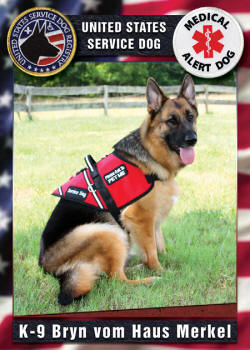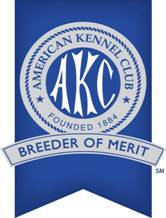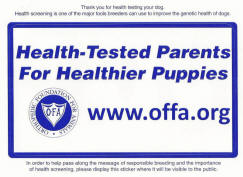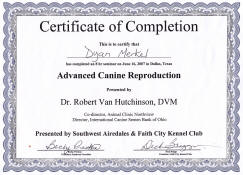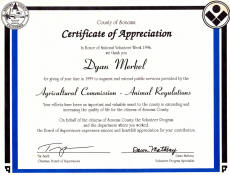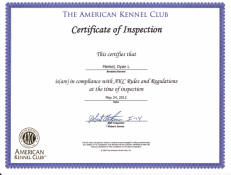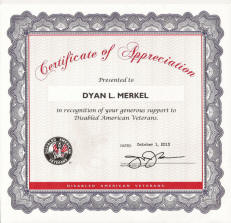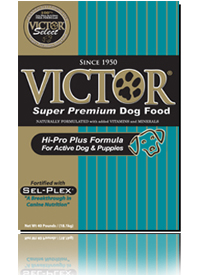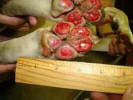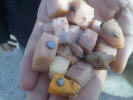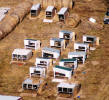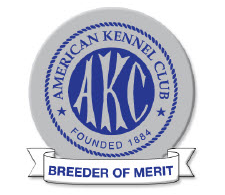|
Understanding
your puppy and its Critical Periods of Emotional
Growth
From
the Complete Dog training Manual by Bruce
Sessions
The five
critical periods.
Scientific
studies have shown that, there are five critical
periods in a puppy's life, that is five phases
of mental development during which adverse
conditions can cripple a dog emotionally without
hope for recovery. Conversely, positive
conditions during these five phases of emotional
growth can produce dogs of the highest calibre -
mentally and socially. So important are these
findings, that guide dog foundations instituted
these "positive conditions" for puppies being
raised to become leaders of the blind. Dogs
trained to lead the blind receive the most
rigorous and exacting training of any dogs and
therefore must be perfectly adjusted.
Dr Paul J
Scott, Director of Animal Behaviour at Roscoe B
Jackson Memorial Laboratory at Bar Harbour,
Maine, directed a project to determine just when
these critical periods took place. The
consequences of a person's failure to
acknowledge and respond to these critical
periods were demonstrated in one particular
test. A puppy 21 days old, was removed from the
litter and completely isolated. Although the
puppy was fed and watered, the caretaker was
careful not to play with or speak to it. The
only toys the experimental puppy had were his
water bucket and food dish. By 16 weeks of age,
the puppy had no contact with other dogs (except
during the first 21 days of its life) and no
human contact except the caretaker.
At four
months of age, the experimental puppy was once
again placed with his litter mates. HE did not
recognise them, either as litter mates or as
dogs! His isolation during the critical periods
of his life - his complete removal from the
companionship of dogs and humans - had marked
his character to the extent that he could not
adjust to animal or human society.
First
Critical Period: 0 - 20 days (0 to 3 weeks).
As a result
of many years of scientific research, it has
been determined that the first critical period
covers the entire first three weeks of a puppy's
life, 0 to 20 days. During this period, a
puppy's mental capacity is nearly zero, and the
puppy reacts only to its needs of warmth, food,
sleep, and its mother. Tests were conducted to
determine whether a puppy was capable of
learning anything at all during the first
critical period; it was determined that it was
not.
Second
Critical Period: 21 - 28 days (3 to 4 weeks).
Scientists
found, however, that something nearly miraculous
happened on the 21st day, and it occurs in all
dogs, regardless of breed. On the 21st day, all
of a puppy's senses begin to function. The
senses were present in the puppy during the
first critical period but were dormant. The 21st
day marks the beginning of the second critical
period.
During this
period (21st to 28th day) the new puppy needs
its mother more than at any other time. The
brain and nervous system begin to develop.
Awareness begins to take place, and in this
mental state, a puppy's experiences can be
rather frightening. A puppy removed from
its mother during this second critical period
will never attain the mental and emotional
growth that it could.
During the
second critical period, the social stress of
being alive has its greatest impact on a puppy.
No other time in a dog's life is so crucial to
emotional growth.
It is during
the second critical period that the
characteristic of nervousness can generate
shyness and other negative qualities in a puppy.
Once negative characteristics have been allowed
to develop (during the second critical period)
no amount of reconditioning or training later in
life alter the negative characteristics.
Third
Critical Period: 29 - 49 days (4 to 7 weeks).
The third
critical period is the fifth through the seventh
week (29 to 49 days). At that age, puppies will
venture away from the nest - although not very
far - and do a little exploring. At the
beginning of a puppy's sixth week, the awareness
of society will dawn; that is, the society of
man and the society of dog. A puppy's nervous
system and his trainability are developing and,
by the end of the third critical period, will
have developed to capacity. Unfortunately some
dog books say that a puppy has the brain of an
adult at the conclusion of the third critical
period. This is not true, and research proves
it.
At the
conclusion of the third critical period (the
seventh week of age), the puppy's nervous system
and trainability have developed to capacity, so
a more comprehensive look at what takes place
during this third critical period is certainly
in order.
During this
period a puppy will learn to respond to voices
and will begin to recognise people. A social
"pecking order" will be established among the
puppies in the litter. Some of the puppies will
learn to fight for their food and will learn to
be bullies. The litter mates that are cowed by
aggressive tendencies of the others will become
shy.
The
scientific tests at Hamilton Station have show
that it is advantageous for a puppy to remain
with the litter long enough to acquire a little
competitive spirit, but that too much is
detrimental to the puppy's emotional growth. The
pups that remain in the litter after the seventh
week will begin to develop bullyish or cowed
tendencies - which will remain with them
into adulthood. The longer a puppy remains with
the litter after completing the seventh week of
its life, the more deteriorated the emotional
growth of that puppy will be.
At the end of
the third critical period, the puppy is
considered emotionally developed and ready to
learn. But the puppy does not possess an adult
brain at that age.
Fourth
Critical Period: 50 - 84 days (7 to 12 weeks).
The
trainability of a puppy is ripe and operating to
capacity as the puppy enters the eight week of
life. Thus, the puppy enters the fourth critical
period of emotion; growth (50 to 84 days). What
the puppy learns during the fourth critical
period will be retained and become part of the
dog's personality. If a puppy is left with its
mother during the fourth critical period, its
emotional development Will be crippled. The
puppy will remain dependent upon her, but in her
will find very little - if any - security.
When a puppy
remains with the litter beyond this time - and
without adequate human contact - its social
adjustment to human society will be crippled,
and what it learns will be learned from the
litter mates. The optimum time for taking a
puppy into a new household is at the conclusion
of the puppy's seventh week.
Because a
pup's trainability and learning facilities are
operating at full capacity during the fourth
critical period, it is better that a puppy do
his learning from his new owner. And learn he
will! The fourth critical period marks a time
when a new puppy will learn at a fast and
furious pace. And much of what he learns will
stay with him a long, long time. What the
puppy learns during the fourth critical period
will help to shape him into the kind of dog he
will be forevermore!
That
paragraph is so important that every dog owner
(and those contemplating getting a puppy) should
reread it - and then read it again! For the
readers who acquired their dogs at six months or
more, that paragraph may well explain some of
the negative characteristics in the personality
and behaviour of their dog.
During the
first three critical periods, in significant
brainwaves from a puppy can be recorder on
electroencephalographs. The fourth critical
period, however, is quite different. The first
actual - and highly significant - waves
can be recorded. It is during this
fourth period that a bond will be established
between dog and man that will have a lasting
effect upon the puppy. During no other phase in
its life will a canine have the ability to
achieve a stronger bond that during the fourth
critical period.
A puppy's
contact with people during this phase is the
whole key to his emotional and social success
within human society. In the tests conducted at
Bar Harbour, puppies were isolated at various
intervals during the five critical periods, and
it was determined that isolation from human
society had its greatest effect on
puppies during the fourth critical period.
Without adequate human contact during the fourth
critical period puppies became incapable
of being trained and incapable of being
companions to man.
It is during
this time that a puppy should be integrated into
human society. At this time, a puppy should be
taken for walks, meet people and be allowed to
play with children and other animals (under
supervision).
During the
fourth critical period, simple commands can -
and should - be taught. There should be gentle
discipline. Forceful discipline during this
period could adversely tip the scales on which
the puppy's emotional development now rests. A
puppy (during the fourth critical period) is
learning to live in a human's world. He is
learning to trust and have confidence in human
beings.
A puppy
between the ages of 8 and 12 weeks does not
deliberately get into mischief. A physical and
forceful correction could result in complete
confusion within the mind of the puppy. Faith
and trust in his new human friends could be
quickly shattered. When mistrust of humans
develops during the fourth critical period, that
mistrust will remain a permanent part of the
puppy's makeup.
Because many
people acquire puppies for home security
purposes, I must digress for just a moment to
put across a very important point. The preceding
paragraph may cause some to assume that the best
way to raise a puppy to be a watchdog is to
isolate it from human society during its fourth
critical period so it will distrust humans. But
this is not the way to train a watchdog. It is
one way to guarantee that a puppy will never be
protective of anything.
During the
fourth critical period discipline should be
confined to scolding. Scolding does not include
shouting. Commands such as "sit", "stay", and
"come" can be taught during the fourth critical
period - but must be done so in a playful
atmosphere. Housebreaking should be instituted
in a gentle manner, insuring that praise is used
for correct behavior rather than forceful
correction for misbehavior.
It is during
the fourth critical period that puppies can
develop what is generally referred to as "Hand
shyness" as a result of owners who feel that
striking a puppy is the only way to discipline
it. A puppy's environment should give him a
sense of security. Being smacked around with
rolled newspaper or human hands certainly will
not achieve this.
Mild
restrictions should be imposed - such as not
allowed the puppy to chew on furniture, shoes,
etc. And these wild restrictions could have the
additional value of raising tolerance levels.
Failure to discipline and failure to impose mild
restrictions could have a serious effect on the
puppy's upbringing and s deleterious effect on
the dog's compatibility within the family later
in life.
In human
society, we have what is known as kindergarten
in our public schools. The purpose of
kindergarten is to prepare a child emotionally
for the learning that will take place later.
Kindergarten and pre-school classes are, in
effect, a training ground to teach children how
to learn. The fourth critical period is the
puppy's kindergarten. If a puppy is taught how
to learn during the fourth critical period his
actual formal schooling (Which can take place
during or after the fifth critical period) will
be more successful. A puppy given pre-school
training during the fourth critical period will
be able to learn more than a puppy that does not
have pre-school experience.
Although
commands such as "come", "sit", "stay", "down",
and "no" are invaluable when taught during the
fourth critical period, perhaps the most
important single response during that period is
learning to fetch. Puppies who cannot - or will
not - learn to fetch are dropped from guide dog
programs. Moreover, dogs being trained to
perform narcotic detection duties must first be
proficient at retrieving. The significance of
fetching cannot be over-emphasized. Explaining
how such a game expands a puppy's mind and what
willingness to fetch reveals about a puppy would
require a book in itself. Learning t fetch in
the fourth critical period can spell success or
failure in your dog's desire and ability to work
for you. The term "work" refers to those duties
which involve specialized training.
Failure to
learn fetching does not mean that a dog will not
be able to learn to respond to commands for
everyday obedience, but stop and think for a
moment if a dog is not smart enough to learn to
fetch how then can he be expected to manage the
more complex tasks of hunting, retrieving game,
pulling a sled, working stock, guarding a house,
or detecting bombs?
Fifth
Critical Period: 12 - 16 weeks (3 to 4 months).
The fifth
critical period is the 13th, through the 16th
week of a puppy's life. A highly significant
thing will happen during the fifth critical
period, and puppy owners should be prepared for
it. A puppy will make its first attempt to
establish itself as the dominant being in the
pack (family). It is during the fifth period
that a puppy will learn whether he can
physically strike out at his owner - and get
away with it!
If a puppy is
allowed to get away with it, he will lose the
confidence and the respect for the owner that
developed during the fourth critical period. The
tolerance level toward the owner will be
narrowed. The puppy will learn that by rebelling
he'll get things his own way. It is during this
fifth critical period that authority will be
challenged. It is here that the challenge must
be met head on by the pup's owner.
Instructing
people as to the best method for dealing with
the problem is quite difficult because not two
dogs are exactly alike. Disciplinary measures
for one are not necessarily suitable for
another. In my own training school the question
is often asked, "What shall I do if my dog bites
me"? My answer usually goes something like,
"What would you do if your child hit you"? Heaps
of love and understanding are not
applicable here. A puppy must be shown swiftly
and firmly that though his is loved, you
the owner - are the dominant being.
Formal
obedience training should begin not later than
the age of six months for optimum ease in
teaching. This is not to say that a dog who has
attained the age of 10 years cannot or should
not be trained. As long as a fog is healthy,
there is no maximum age limit for training, It
is always easier to train a dog that has not had
too much time to develop bad habits.
Being aware
to the five critical periods, providing the
correct environment during these periods, and
instituting proper learning techniques will
allow a puppy to develop emotionally and
socially to full potential. Each tome you marvel
at a guide dog leading its blind owner through
busy traffic, you can be assured that the five
critical periods in that dog's life were handled
with great care and concern.
The puppy you
acquire can grow up to be all the things he is
capable of becoming. Pay close attention to the
critical periods in his life. Those are the
periods which shape and mould his character and
personality. He is in your hands. What he is to
become he will become during those five critical
periods.
Most formal
obedience classes conducted throughout the
country will not accept a puppy for obedience
training unless it has attained the age of six
months or more. It is unfortunate, however that
by the time some dogs reach six months of age,
they have already become problem dogs. Obedience
training may or may not help, depending upon the
severity of the problem. In too many cases, it
does not. This is simply because obedience
training does not teach a dog to refrain from
turning over trash cans, chasing cars, barking
excessively, or tearing up the living room
furniture; these bad habits are learned during
the five critical periods.
The Pack
Instinct.
The natural
instinct of the canine is to try to assume
dominance within the pack. As was stated
earlier, he begins this during the fifth
critical period, and the dog will periodically
"test" the owner's ability to dominate. The fact
that a dog will periodically test the owner's
dominance does not mean that the dog does not
love or respect that owner. However, if the
owner is permissive and weak - thus allowing the
dog to achieve dominance - his love and respect
for the owner will quickly wane. The dog owner
then becomes inferior in the dog's eyes, and the
owner is destined to be owned by the dog. The
scales of love and discipline must be equally
balanced. That is the magic formula for success
in the rearing of any puppy.
Security:
Prime Ingredient For Emotional Growth.
Although your
new puppy may be destined to become the family
dog, one member of the family should be
designated the puppy's foster mother during the
remaining critical periods in its life. This is
not to suggest that other members of the family
should be restricted in their association with
the puppy. On the contrary, all should share in
the joy of caring for - and playing with - the
new arrival. But the bond between the puppy and
its litter mother has been severed by removal
from the litter. For optimum emotional
development, the puppy should have the security
of knowing which member of the human family has
taken the litter mother's place.
It is
strongly urged that a child member of the family
not be given this responsibility if optimum
emotional growth is to be achieved. Many
children are presented with puppies to "help the
child to develop responsibility". But in all too
many cases, it does just the opposite; often
children will find excuses why they cannot take
the time to feed, water, train and care for
their new charges. Dog pounds and humane
societies (not to mention research laboratories)
are filled to overflowing with dogs and puppies
awaiting execution because their child-owners
failed to develop the hoped-for responsibility.
A puppy knows
very well when it is unwanted. Being unwanted
brings insecurities to a puppy, just as it does
to a human. Insecurities breed emotional
problems. Emotional problems during the puppy's
critical periods will remain as personality
faults throughout the dog's life. The
personality faults can cause fear biters,
piddlers, runaways and perhaps complete
emotional withdrawal from human society.
To increase
the puppy's security, he should have his own bed
in a place where he can be alone when he wants.
You must expect the first four nights to lend
themselves to some inconvenience - for you and
the rest of the family. Your new puppy will be
lonely at night, having been accustomed to the
presence of his litter mates. Although the puppy
may have been playful during the first day in
his new household, nightfall - when you and the
rest of the family have gone to bed - will give
the puppy time to remember (and miss) his litter
brothers and sisters. By the fourth night,
however, the pup will have adjusted to his new
environment and to your family's routine. It
takes just four days for the average dog to
learn to adjust to a new environment.
The Puppy
Crate.
The value of
such a crate cannot be over emphasised. For value
received, such a crate can be one of your best
investments. Teaching a puppy to accept the
crate (referred to as "crate breaking") is not
difficult at all. It will require a little
patience on your part until your puppy realises
that the crate is his bed (and his eating place
at first), that it is comfortable and safe.
You will find
that the use of a crate will assist you in one
of the more difficult jobs - toilet training. By
nature, a canine does not want to soil its
sleeping quarters. A puppy will have a tendency
to "hold it" until he is let out of the crate. A
puppy can be completely crate broken within four
days of being introduced to it. The crate is
like a dog house, except that the crate has a
door that can be closed and locked.
Puppy crates
are collapsible and easily carried. A large
crate suitable for a full grown German Shepherd,
would cost about $130.00. When purchasing your
crate, keep in mind that your puppy will grow;
there's not much sense in getting your puppy
used to sleeping in his crate if he outgrows it
in two months. Get a large crate.
Puppy
Nutrition.
The scope of
puppy's security must also include a proper
nourishment. The work of preparing a complete
and balanced diet has already been done for you
by the manufacturers of commercially prepared
dog food. If you select a puppy food in which
the label states, "complete and balanced for
growth", you won't need to worry about adding
vitamins and mineral supplements. They've
already been added. If you add more, you then
run the risk of creating an imbalance of
nutrients.
Most
veterinarians will recommend vitamin and mineral
supplements until a puppy reaches one year of
age if the puppy is eating what is known as a
"maintenance diet". That is, a diet prepared for
the daily maintenance of adult dogs. Your
veterinarian is your best consultant since he
can examine your puppy personally and evaluate
its nutritional needs.
It is not the
purpose of this book to get into the technical
aspects of canine nutrition, but a proper diet
for a puppy during the five critical periods of
emotional growth is important. A puppy that is
not getting enough to eat, getting too much, or
not receiving the proper nutrients can hardly
develop properly. For a more definitive look at
proper canine nutrition, the digestive system
etc., the reader is referred to this author's
work titled "Dog Owners Medical Manual", (TAB
book number 813, Blue Ridge Summit,
Pennsylvania).
Seventy
percent of your new puppy's metabolism is water.
He will need plenty of it - all the time. His
water bowl should be cleaned each day. Water
allowed to sit will develop scum, and diseases
can result from an unclean bowl, such as
gastrointestinal, just as it can from unclean
feeding dishes. Dry, caked-up food can breed
harmful bacteria. A clean water bowl and clean
feeding dish will lessen the chances of
gastrointestinal upsets and resultant
veterinarian bills. A puppy that is constantly
thirsty - or constantly hungry - cannot feel
very secure.
Socialization.
In bringing
your puppy home when it is eight weeks of age,
you must remember that it is in its fourth
critical period. Your puppy must be socialized
with the human element. Not just with you, but
with other humans as well. Your puppy should be
taken for walks in public. HE should be allowed
to meet people and be allowed to play with
children (under close supervision).
In too many
cases, puppies are kept isolated from the
outside world. They are not allowed to see just
what goes on out there. Their world consists of
the inside of the house or the backyard. As they
pass through fourth and fifth critical periods
without proper socialization, great damage is
done.
Note:
One should not let one's puppy mix with other
dogs, or go places where dogs congregate until
all Parvo inoculations complete, preferably at
16 weeks, but it may be safe to let the pup
socialize at 12 weeks as long as he is with
inoculated animals. Parvo is especially virulent
during the summer months in Zimbabwe.
Conversation.
A puppy that
can respond only to words like "good boy", or
"here boy", can never achieve the full measure
of mental growth. You can enrich your life and
expand your puppy's mind by speaking to him -
frequently.
While formal
obedience training during the puppy's fifth
critical period will add to the joy of owning a
dog, help in his day-to-day control, and make
him a better, well-mannered member of your
family, your puppy (during the 8th to the 12th
week) needs conversation from you. Though it is
true that your puppy will have no idea what you
are saying, he will know you are paying
attention to him - and that is what is important
. Your puppy must feel secure in his new
environment. Conversation from you, your
enthusiastic and warm tone of voice, will help
to create that necessary feeling of security. |

